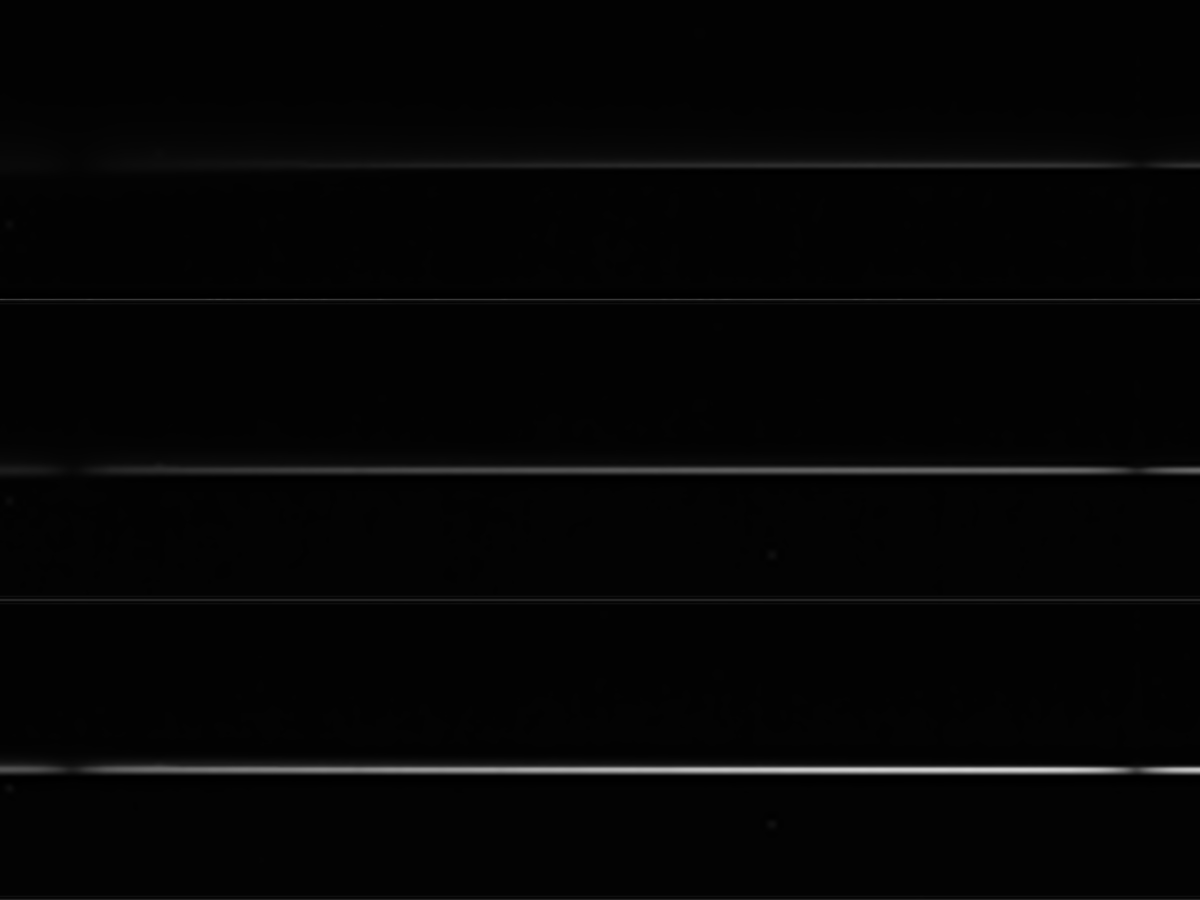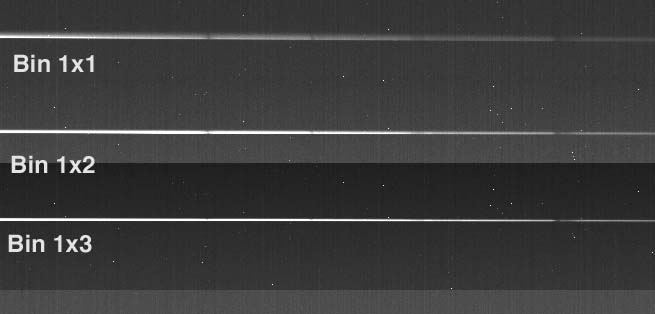Page 1 of 2
LISA and correct FLAT image for calibration
Posted: Mon Nov 23, 2020 12:16 am
by Rainer Ehlert
Hi,
I am starting again with Spectroscopy with my LISA and have a question in regard to correct exposure time for the Master FLAT for calibration.
I have the FLAT / NEON accessory. Below the FLAT I am using but I have the feeling like the center part is to bright

I am using a QSI 520i in binning X1 x Y3 and it has a 7.4 micron pixel and CCD KAI-2020 and 40.000 e full well
I do all my preprocessing using PixInsight eg. applying BIAS, DARK and FLAT to my images. I stack up to 20 images ofor each Master spectrum.
Thanks for any tips
Re: LISA and correct FLAT image for calibration
Posted: Mon Nov 23, 2020 10:05 am
by Olivier GARDE
Hi rainer,
For a good flat, you need to take let say 30 flats with a dynamic around 2/3 of the range of your sensor.
With your CCD (16 bits) you have a maximum of 65536 ADU.
With my own experience, I take 30 facts around 50000 ADU each. (see the copy screen below)

You will see that the flat level in the blue part of the spectrum is very low, so, that's why you need to take many flat. (to increase SNR in the blue part)
You can check the ADU level with you acquisition software (here it's Maxim DL, but you can of course use others softwares.)
After for processing spectra, it's necessary to use only one software for the whole process like Demetra, ISIS, Vspec, spcaudace, bass for example...
Do not use a binning 1x3 that could be a problem during the process if your spectrum wide is around 2 pixels...
Re: LISA and correct FLAT image for calibration
Posted: Mon Nov 23, 2020 5:54 pm
by Rainer Ehlert
For a good flat, you need to take let say 30 flats with a dynamic around 2/3 of the range of your sensor.
Hi Olivier,
Thank you very much for the explanation.
I made 20 FLATS and stacked them. The attached image of the FLAT is a 20 image stack in Pixinsight. Will test with 30 and as you said 2/3 ADU.
I use binning X1 x Y3 because that is the way I take my spectra. The camera sensor has 1600 x 1200 pixel and binning 1x3 I get 1600 x 400 and so II increase the sensitivity by 3 in the vertical plane which helps me achieve shorter exposure times or better said I gain more when I have very faint objects.
I am practicing at the moment at stars with low magnitude and so get an idea of needed exposure times. for example for a star I made yesterday HP 009829 G2V star with magnitude 7 i exposed 120 seconds and so on ...
Do not use a binning 1x3 that could be a problem during the process if your spectrum wide is around 2 pixels...
Thanks for the above. Will test using the camera in binning 1x1. Yes my spectra are only 1 to 2 pixels wide. Never thought about that. Thanks again.
After for processing spectra, it's necessary to use only one software for the whole process like Demetra, ISIS, Vspec, spcaudace, bass for example...
Will download that software packages and practice with them. They have been always daunting to me and difficult to understand, specially ISIS. I did no know Demetra can process spectra from LISA spectrograph. Now that I am retired I have 24 hours a day for learning new things



Again Mercy and Merci

Rainer
Re: LISA and correct FLAT image for calibration
Posted: Tue Nov 24, 2020 3:34 pm
by Benjamin Mauclaire
Hi Rainer,
If that may help you, hereafter links to tutotial how to easly process spectra of Lisa equiped with Relco lamp with Spcaudace:
1/ Instrumental response computation:
http://spcaudace.free.fr/docs/index.php ... lcop1.html
2/ Targets processing:
http://spcaudace.free.fr/docs/index.php ... cop2a.html
3/ Nebular targets processing:
http://spcaudace.free.fr/docs/index.php ... ine2b.html
Use Google translate to get it in english.
Video are avaible in these tutos too.
Cheers,
Benji
Re: LISA and correct FLAT image for calibration
Posted: Wed Nov 25, 2020 6:18 pm
by Rainer Ehlert
Do not use a binning 1x3 that could be a problem during the process if your spectrum wide is around 2 pixels...
Hi Olivier,
In regard to above I made a little test and took the same Object in binning 1x, 2x and 3x and I see no difference in the width of my spectrum.
You comment helped me to better align my camera to the spectrum. Thanks.
See attached images.
1x Binning
2x Binning
3x Binning
Re: LISA and correct FLAT image for calibration
Posted: Thu Nov 26, 2020 7:40 am
by Olivier GARDE
It's very strange....
Have you check the fit header with the key word about binning and image size in pixel ?
You will have the binning factor in X, in Y and image size in pixels.
Re: LISA and correct FLAT image for calibration
Posted: Thu Nov 26, 2020 4:11 pm
by Rainer Ehlert
Olivier GARDE wrote:It's very strange....
Have you check the fit header with the key word about binning and image size in pixel ?
You will have the binning factor in X, in Y and image size in pixels.
Hi Olivier,
I did not save the images. I just made a screenshot crop but I can repeat the experiment for you.
Rainer
Re: LISA and correct FLAT image for calibration
Posted: Fri Nov 27, 2020 1:25 am
by Rainer Ehlert
Hi Olivier,
I had a window between the clouds and was able to get Vega into LISA and made same 1 second exposure for each.
For better view I resized it. This is the result from top to bottom 1x, 2x and 3x

- Vega_1x_2x_3x_binning.jpg (52.45 KiB) Viewed 7946 times
here from this link you can download the 3 fit images for comparison if you like.
https://rainerehlert.com/000_LISA/
Thanks and regards Rainer
Re: LISA and correct FLAT image for calibration
Posted: Fri Nov 27, 2020 8:24 am
by Olivier GARDE
Your spectra look good and the binning mode is ok in Y axis.

For my own opinion, it's better to use the bin 1x1 mode because when you process your spectrum, you have to define a binning area and if this binning area is too thin, you may have a problem with the result.
Re: LISA and correct FLAT image for calibration
Posted: Fri Nov 27, 2020 3:12 pm
by Robin Leadbeater
Binning just in Y is interesting with faint objects and CCD cameras as it can potentially reduce read noise without losing resolution, particularly if combined with optimal binning algorithms like in ISIS. You must not go too far though or you start adding extra read and sky noise from pixels which have no signal from the star.
Cheers
Robin


